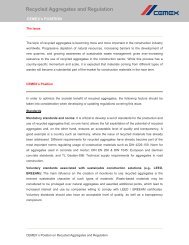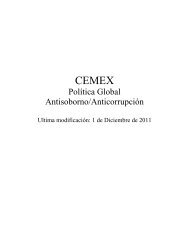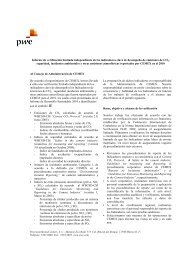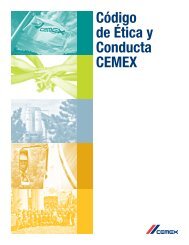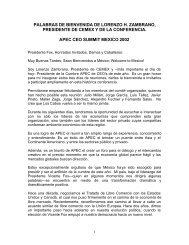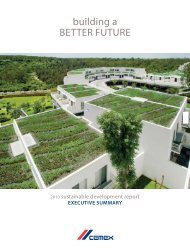building a STRONGER foundation - Cemex
building a STRONGER foundation - Cemex
building a STRONGER foundation - Cemex
Create successful ePaper yourself
Turn your PDF publications into a flip-book with our unique Google optimized e-Paper software.
On the legislative front, during the past few years, various bills have been introduced in the U.S. Congress seeking to establish<br />
caps or other limits on GHG emissions. It is not possible at this time to predict whether any federal climate change legislation may be<br />
enacted, what that legislation may provide or whether it may impact existing federal regulations or state laws or regulations on GHG<br />
emissions. Therefore, it is not possible at this time to predict how such legislation would impact our U.S. operations. However, any<br />
impositions by legislation of significant costs or limitations on raw materials, fuel or production, or requirements for reductions of<br />
GHG emissions, could have a significant impact on the cement manufacturing industry and a material economic impact on our U.S.<br />
operations, including competition from imports in countries where such costs are not imposed on manufacturing.<br />
In addition to pending U.S. federal regulation and legislation, states and regions are establishing or seeking to establish their<br />
own programs to reduce GHG emissions, including from manufacturing sectors. For example, California passed AB 32 into law in<br />
2006, which, among other things, seeks a statewide reduction of GHG emissions to 1990 levels by 2020. In December 2008, the<br />
California Air Resource Board (“CARB”) approved a plan to implement AB32, which includes a cap-and-trade program beginning in<br />
2012. The program has been challenged in litigation, but if it takes effect, there can be no assurance that it will not have a material<br />
impact on our operations in California.<br />
Also, in 2007, CARB approved a regulation that will require California equipment owners/operators to reduce diesel particulate<br />
and nitrogen oxide emissions from in-use off-road diesel equipment and to meet progressively more restrictive emission targets. In<br />
2008, CARB approved a similar regulation for in-use on-road diesel equipment. The emission targets will require us to retrofit our<br />
California-based equipment with diesel emission control devices or replace equipment with new engine technology in accordance with<br />
certain deadlines, which will result in higher equipment related expenses or capital investments. The company may incur substantial<br />
expenditures to comply with these requirements. In December 2010, CARB amended both regulations to grant economic relief to<br />
affected fleets by extending certain compliance dates and modifying compliance requirements.<br />
Finally, there are ongoing efforts on the international front to address GHG emissions. We are actively monitoring negotiations<br />
of the United Nations Framework Convention on Climate Change (“UNFCCC”), and we operate in countries that are signatories to the<br />
Kyoto Protocol, which establishes GHG emission reduction targets for developed country parties to the protocol, such as the countries<br />
of the European Union. Hence, our operations in the United Kingdom, Spain, Germany, Latvia and Poland are subject to binding caps<br />
on CO2 emissions imposed by member states of the European Union as a result of the European Commission’s directive establishing<br />
the European Emissions Trading System (“ETS”) to implement the Kyoto Protocol. Under this directive, companies receive from the<br />
relevant member states set limitations on the levels of CO2 emissions from their industrial facilities. These allowances are tradable so<br />
as to enable companies that manage to reduce their emissions to sell their excess allowances to companies that are not reaching their<br />
emissions objectives. Failure to meet the emissions caps is subject to significant monetary penalties. For the years 2008 through 2012,<br />
the European Commission significantly reduced the overall availability of allowances. In December 2008, the European Commission,<br />
Council, and Parliament reached an agreement on a new Directive that will govern emissions trading after 2012. One of the main<br />
features of the Directive is that a European-wide benchmark will be used to allocate free allowances among installations in the cement<br />
sector according to their historical clinker production. On April 27, 2011, the European Commission adopted a Decision setting out<br />
the rules, including benchmarks of GHG emissions performance, to be used by the Member States in calculating the number of<br />
allowances to be allocated free annually to industrial sectors, including the cement sector, that are deemed to be exposed to the risk of<br />
carbon leakage. Based on the criteria in the Decision, we expect that the aggregate amount of allowances that will be annually<br />
allocated for free to CEMEX in Phase III of the ETS (2013-2020) will be sufficient to operate, assuming that the cement industry<br />
continues to be considered a trade exposed industry. As a result of continuing uncertainty regarding final allowances, however, it is<br />
premature to draw conclusions regarding the overall position of all of our European cement plants. Also, separate cap-and-trade<br />
schemes may be adopted in individual countries outside the EU. For example, there is now a trading scheme in place in Croatia.<br />
Under the ETS, we seek to reduce the impact of any excess emissions by either reducing the level of CO2 released in our<br />
facilities or by implementing clean development mechanism (“CDM”) projects under the Kyoto Protocol in emerging markets. We<br />
have registered 5 CDM projects. If we are not successful in implementing emission reductions in our facilities or obtaining credits<br />
from CDM projects, we may have to purchase a significant amount of allowances in the market, the cost of which may have an impact<br />
on our operating results.<br />
Although we monitor other international efforts to regulate GHG emissions carefully, it is more difficult to estimate the<br />
potential impact of any international agreements under the UNFCCC or through other international or multilateral instruments. A<br />
Conference of Parties was held in December 2010 in Cancún, Mexico, but no binding legal agreements were reached there.<br />
In conclusion, given the uncertain nature of the actual or potential statutory and regulatory requirements for GHG emissions at<br />
the federal, state, regional and international levels, we cannot predict the impact on our operations or financial condition or make a<br />
reasonable estimate of the potential costs to us that may result from such requirements. However, the impact of any such requirements,<br />
whether individually or cumulatively, could have a material economic impact on our operations in the United States and in other<br />
countries.<br />
15



